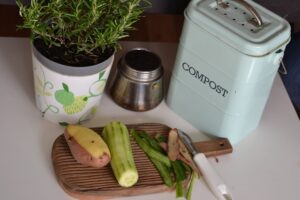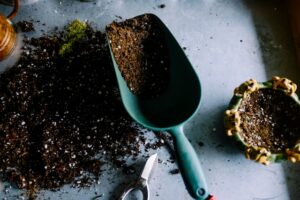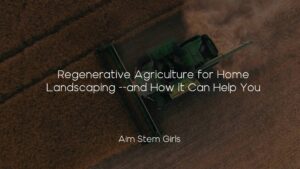If you’re reading this, you’re likely searching for new ways to optimize your home agriculture and landscaping operations: and hey, fair enough. I’ve had the privilege of speaking to “plant moms,” “Home Depot dads,” and every flavor of agriculture and plant science nerd. Judging by the title of this article, you probably also know what I’m going to advocate for you.
That’s right.
Regenerative Agriculture.
Curious? Great. Let’s explain.
But, before we get to that, a little background information about my personal experience with this method. Then, how it’ll help you.
Introduction:
I’m Shreya. I’m a plant science nerd who likes talking about all things plants. I create these blog articles to help other fellow plant sciences nerds find creative ways to qualify their passion for the field.
Now, here’s my experience with regenerative agriculture.
Every year at the onset of Spring, my family and I plant for landscaping and grow vegetables in the vegetable patch in our backyard. It is our yearly tradition, and we love taking care of our plants to have a beautiful landscape and a constant nutritious source of organic herbs and vegetables. However, lately, we’ve been observing a noticeable dip in the health and growth of our green friends.
I have been researching plant science for over three years now in my school and college. I also use a lot of what I learn and research and apply it to my family’s backyard garden and landscaping. (And, of course, if you’re interested in learning more about my applied plant science methods or just want to learn more about how to improve your own backyard plant projects, consider joining our newsletter!)
What is Regenerative Landscaping?
Based on my research on this subject in my laboratory, I found that the cause for the stunted growth of the plants is largely due to poor soil quality, and it has severely impacted my home garden too.
The most widely practiced method of managing the slow growth of plants is by spraying chemicals and fertilizers (with super long names we can’t even pronounce.) Studies also show that the current use of chemical pesticides is linked to increased development of cancer and chronic illnesses.
This puts us in an impasse. How can everyday growers maximize plant health whilst minimizing intrusive chemicals and pesticides?
The good news is that there are natural and less-intrusive methods to rejuvenate and restore soil quality. This method of unintrusive soil regeneration is called Regenerative Landscaping or Farming.
Regenerative Landscaping is a sustainable practice that aims to restore and enhance the health of ecosystems through improved soil health and biodiversity, primarily through organic and locally sourced materials for landscaping and gardening.
Think of it as a path toward the best outcome of soil health without all the negative side-effects -a maximization of ROI if you would.
Sometimes companies, institutions, farms, and individual plant nerds like you and I will prioritize certain variables in the plant-growing process. Some may put profit as the #1 priority *ahem, private companies.* Some may prioritize time, efficiency, and effectiveness. Most growers at the individual level like you and I would prioritize whatever option reduces the most risk for health defects. After all, why should we continue harming our land when a natural alternative like Regenerative Landscaping and Farming gives us a sustainable solution for the community?
Regenerative Landscaping Helped Our Family, and it May Help You Too.
This blog will take you through my personal journey with regenerative landscaping and ways you can spread this in your community!
Here are some statistics to show the benefits of this method:
- Regenerated soil can improve water retention in soil by up to 50%.
- Now, why should we care? In Texas, summers are getting hotter by the year, which means we try to use MORE water to keep our yards looking pretty but that unfortunately leads to MORE droughts. That’s bad on a conservation and preservation level, bad on a profit level, and bad on a spiritual level, and… well, you get the point.
- Those transitioning to a regenerative landscaping practice can increase their yields of fruits and vegetables by up to 25%!
- Oh, and in the long run, profitability actually increases for farmers despite the initial drop in yield during transitioning periods. Sure: crop insurance and subsidies currently favor conventional farming practices at the moment.
Some of the other useful benefits that come with Regenerative Landscaping and Farming methods are the reduced labor costs in the long run. After transitioning from conventional to Regenerative, you’ll realize your soil requires less tilling than typical. This ensures any plant growth operations you run won’t be as strenuous as they normally would be, which is nice for small-scale operations and fantastic for large ones.
In terms of plant health, you can improve your soil quality with Regenerative Landscaping by introducing natural compost and earthworms into the soil. This provides enhanced nutrition, thereby leading to robust plant growth.
Perhaps one of the most important takeaways to consider about Regenerative Landscaping is the sustainability of operation management. Compost production is easily achieved in each house by establishing a basic food recycling system that includes edible waste, plant clippings, and other organic matter. Normalization of a compost system ensures one doesn’t need to worry about the cost of compost, and perhaps more importantly, reduces the mental labor that goes into Regenerative Landscaping efforts –making the switch easier and more streamlined than otherwise expected. Moreover, the use of organic mulch can help conserve water resulting in less sprinkling or watering required.
I started a compost bin during the summer of 2020 and regularly toss our vegetable scraps and coffee grounds in the soil. Of course, we’re just a single family; so, we’re not expecting to create enough compost to support an entire farm or whatnot. This is a small operation here. Don’t expect to see compost overnight, it takes months to years for it to degrade!
Oh, and take these Amazon links as a sign to get your very own compost bin!
Want to start small? Click Here
Ready to get a large bin for the yard? Click Here
Our family has implemented this strategy in our backyard, and we have started seeing remarkable results. The growth game has changed – gradually the plants have been exhibiting healthy growth with abundant yield from our favorite gourd, cucumbers, and green chili plants.
Regenerative Landscaping creates solid benefits that can make a REAL difference – not just for our plants, but for our wallets and environment!
However, perhaps the biggest advantage that regenerative landscaping has for us is providing safe food items devoid of cancer-causing chemicals and pesticides. This is a massive boon, and one of the biggest reasons for most families –even those who do not or don’t consider themselves backyard farming types. It allows you to have autonomy over what goes into your body without being susceptible to the workings of food suppliers who prioritize their profits over your health.
I truly admire the efforts our community has made in raising environmental awareness among our citizens on a national and global level. But I think we can give regenerative landscaping a bit more attention and add this to our existing efforts of sustainability. A wide misconception is that regenerative agriculture is only applied to farming on large plots of land. While it is true that the results and practices are much more applicable to farmland, the concept can be applied even to your small desk plants!
February 14th is National Regenerative Agriculture Day (yes, the same day as Valentine’s Day!). You probably have never heard of that, which shows the lack of awareness society has about this issue! So, the next time you give your loved one a box of chocolates, consider also gifting them a small plant. If you’re a beginner, an easy-to-care-for-plant that’s low-maintenance, looks pretty, and supports the “ecosystem” in your home would be suitable. We’re thinking something like a robust aloe plant is a good start; and oh, learn how to take care of it!
What You Can Do About Regenerative Landscaping if You’re a Student.
Now, let’s say you’re a frequent Aimstemgirls reader. Great! Let’s also say you’re an aspiring future stem girl looking for a solid extracurricular that would help the community and environment while you’re at it. Even better! Advocacy for regenerative landscaping is perfect, and doesn’t need to be limited to what you do in your backyard, either!
For, one great activity for you or your kids is to advocate for more regenerative landscaping practices at the local government level. Create more awareness in your city/state through city-wide campaigns, educational events, workshops, and community outreach programs. This is the next step past regenerative landscaping in your home to truly make a difference in the community. By advocating at the local government level, you’ll be impacting schools, community centers, and local businesses.
Note: it’s important to remember that outreach and advocacy always “feels” as if it makes no difference in the grand scheme of things. But, keep in mind that students and younger people often lack the world experience –yeah, yeah; I know, I’m one to talk– to understand the power and influence networking and communication have. For, from a human data perspective, one person is connected to many people; and, said connections are connected with many others. So on and so forth. It’s crucial to remember all advocacy movements whether for regenerative landscaping or for anything regarding plant and environmental advocacy is going to have some pushback; but, you’ll be surprised how people are capable of following along.
Now, if you’re a student looking to advocate for regenerative landscaping, or just better growing practices at the local level as a whole, we’ve got some examples.
Some examples of possible community outreach programs would be:
- Working with local sustainability organizations to showcase regenerative practices at their annual events and city celebrations.
- Collaborating with your local school district to have a ‘regenerative landscaping + sustainability’ program on Feb 14th. It could just be a short presentation by the teachers to make students aware of the landscaping practice or a short message on the morning announcements.
- Offer residents the option to conduct soil tests from samples in their yard or at other central locations to determine the health of the soils. A laboratory soil test will shed great insight on the quality of your soil, so that you can tailor your agricultural practices to fit the needs of your soil!
- Partner with local businesses that are focused on gardening and outdoor merchandise to hang up fliers detailing safe agricultural practices and generally spreading more awareness about the topic. You can even put up flyers in our public library and feature sustainability books on display in the library corridors.
- Encouraging a city-wide composting program where the community is able to take part in a composting program for a small fee. Implementation of this program would also encourage the concept of composting and at the same time reduce organic food waste ending up in landfill.
These are all proposals I have discussed with my city and senate representatives, and I hope you will also reach out to your policymakers and join the cause of implementing regenerative landscaping!










